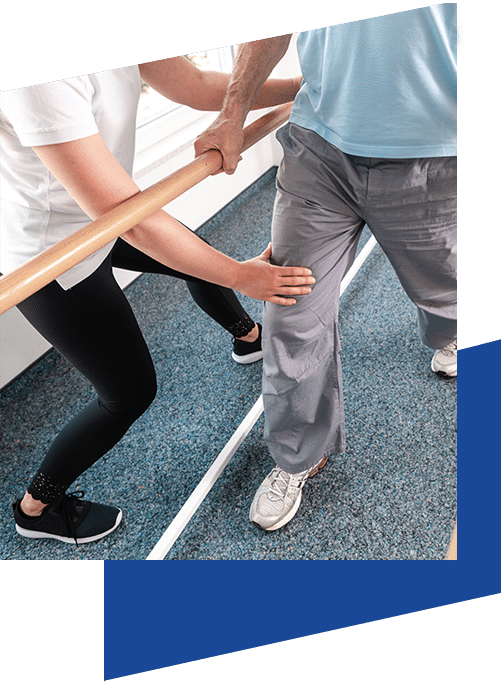Gait refers to a person’s manner of walking. Did you know that gait and balance disorders affect millions of people worldwide, especially as we age? If you’re experiencing difficulties with your gait or balance, you’re not alone.
At Infinity Allied Healthcare, we understand the significance of gait and balance disorders and their impact on daily life.
Let us guide you through effective gait and balance assessments and treatments designed to improve your mobility problems and stability.
Contact us to book your consultation or book online.
Advanced Physiotherapy Advanced and modern manual therapy and hands on techniques. |

1 on 1 |

Quick |
Highest Standard |
What is a Gait and Balance Disorder?

Physiotherapists work closely with patients to treat gait and balance disorders.
A gait and balance disorder refers to any condition that affects the way you walk or maintain stability while standing or moving. These issues can arise from various causes and may lead to discomfort, limited mobility, and an increased risk of falls.
Causes of gait and balance disorders
- Neurological Conditions: Neurological disorders such as Parkinson’s disease, multiple sclerosis (MS), stroke, spinal cord injuries, and brain tumours can affect the brain’s ability to control and coordinate movement.
- Musculoskeletal Issues: Conditions that affect the muscles, bones, and joints, such as arthritis, osteoporosis, muscle weakness, and joint pain, can impact a person’s ability to maintain proper balance and walk steadily.
- Vestibular Disorders: The vestibular system, located in the inner ear, plays a crucial role in maintaining balance. Disorders of the vestibular system, such as vestibular neuritis or benign paroxysmal positional vertigo (BPPV), can cause dizziness and instability.
- Injuries: Traumatic injuries, especially those affecting the head, spine, or lower extremities, can disrupt normal gait patterns and affect balance.
- Age-Related Changes: In older people, natural changes in muscle strength, joint flexibility, and sensory perception can contribute to gait and balance problems, increasing the risk of falls.
- Peripheral Neuropathy: Damage to the peripheral nerves, often due to conditions like diabetes, can lead to numbness, tingling, and muscle weakness, affecting gait and balance.
- Medications: Some medications may cause side effects that affect coordination and balance, increasing the risk of gait disturbances.
- Orthopaedic Surgeries: Certain orthopaedic surgeries, particularly those involving the hips, knees, or ankles, can temporarily impact a person’s gait and balance during the recovery period.
- Inner Ear Infections: Infections of the inner ear, such as labyrinthitis or Meniere’s disease, can disrupt the balance system and cause vertigo.
- Other Medical Conditions: Various medical conditions, such as heart problems, vision impairments, and autoimmune disorders, may indirectly affect gait and balance.
Symptoms of gait and balance disorders
Some common symptoms include:
- Unsteadiness: Feeling unsteady or wobbly while standing, walking, or changing positions is a common symptom of gait and balance disorders.
- Difficulty Initiating Movement: Some people with gait and balance disorders may find it challenging to initiate movements, such as taking the first step when walking or getting up from a seated position.
- Frequent Falls: A significant symptom of gait and balance disorders is an increased frequency of falls.
- Abnormal Gait: Gait abnormalities are common in patients with gait disorders. These abnormalities can include shuffling, limping, walking with an unusually wide or narrow base, or dragging one foot while walking.
- Incoordination: Lack of coordination in movement, such as difficulty with heel-to-toe walking (tandem gait).
- Dizziness and Vertigo: Some gait and balance disorders, especially those related to inner ear issues, may cause sensations of dizziness or vertigo, where the person feels like their surroundings are spinning or moving.
- Muscle Weakness: Weakness in the muscles responsible for maintaining balance and supporting the body during movement can lead to gait disturbances.
- Numbness or Tingling: In cases where peripheral neuropathy contributes to gait and balance problems, patients may experience numbness, tingling, or loss of sensation in their feet and legs.
- Staggering or Reeling: patients with severe gait and balance disorders may appear as if they are staggering or reeling while walking, and they may have difficulty staying upright.
- Discomfort or Pain: Gait and balance disorders can sometimes cause discomfort or pain in the legs, feet, hips, or lower back, further affecting a person’s ability to move comfortably.
Diagnosis of gait and balance disorders
Diagnosis of gait and balance disorders involves a comprehensive evaluation, gait and balance assessments play a crucial role in this diagnostic process.
Gait and balance assessments
Gait and balance assessments are a series of tests and evaluations designed to analyse a person’s walking pattern, balance, and overall stability. These assessments are typically conducted in a clinical setting and may involve various methods to gather comprehensive information about the patient’s condition.

Assisted walking devices can be used as part of the treatment for gait and balance disorders.
Other assessments include:
- Physical examination: The assessment will observe the patient’s gait while walking on level ground, changing direction, walking on stairs, and performing other movements.
- Functional Tests: to assess the patient’s ability to perform specific movements, such as standing up from a seated position, walking on their toes and heels, and maintaining balance on one leg.
- Balance Testing: Balance testing may involve tasks that challenge a patient’s stability, such as standing on a foam surface with eyes closed or performing specific balance exercises.
- Patient History: The healthcare provider will also gather a comprehensive medical history, including information about any previous injuries, medical conditions, surgeries, medications, and lifestyle factors that may contribute to the gait and balance disorder.
Types of physio treatment for gait and balance disorders
Some common types of physiotherapy treatments for gait and balance disorders:
- Exercise Programs: Personalised balance and gait exercises are a fundamental aspect of gait and balance disorder treatment. These programs may include strengthening exercises to target specific muscles and improve overall stability and balance.
- Gait Training: Gait training focuses on improving walking patterns and restoring a more natural and efficient gait. This may involve exercises that address gait abnormalities, stride length, step symmetry, and foot positioning.
- Manual Therapy: Manual therapy techniques may be used to address joint stiffness, muscle imbalances, and soft tissue restrictions that could contribute to gait and balance issues.
- Assistive Devices: Physiotherapists may recommend and provide assistive devices, such as canes or walkers, to support walking, improve stability and falls prevention. They may also prescribe orthotic devices, like foot braces, to enhance foot and ankle support.
Benefits of gait and balance assessments and treatment
Some of the key advantages include:
- Accurate Diagnosis: Gait and balance assessments help in accurately diagnosing the underlying cause of the problem. Identifying the specific issues allows physiotherapists to tailor a targeted treatment plan that addresses the root cause of the disorder.
- Personalised Treatment: Based on the assessment results, physiotherapists develop personalised treatment plans tailored to each patient’s needs and goals. This personalised approach enhances the effectiveness of the treatment and optimises outcomes.
- Improved Mobility: Physiotherapy treatment aims to improve gait patterns, increase muscle strength, and enhance overall mobility. As a result, patients experience improved ease and confidence in their movements, making daily activities more manageable.
- Enhanced Balance and Stability: Through targeted exercises and balance training, patients can enhance their sense of balance and stability, reducing the risk of falls and injuries.
- Falls Prevention: Gait and balance treatment focuses on strategies preventing falls, teaching patients how to recognise and respond to potential hazards in their environment. This empowers them to maintain their independence and reduce the risk of falls.
- Pain Relief: Physiotherapy can help alleviate pain associated with gait and balance disorders. By addressing muscle imbalances and joint issues, patients experience reduced discomfort during movement.
- Increased Confidence: As gait and balance improve, patients gain confidence in their ability to move and perform daily activities, leading to improved overall well-being.
- Functional Independence: Physiotherapy aims to enhance functional abilities, allowing patients to perform everyday tasks with greater ease and independence.
- Improved Quality of Life: Overall, the benefits of gait and balance assessments and treatment contribute to a better quality of life. patients can regain their ability to participate in activities they enjoy and experience improved physical and emotional well-being.
Cost of gait and balance assessments and treatment
The cost of gait and balance assessments and treatment can vary depending on factors such as the type of treatment, duration and severity of the condition
Expenses may include medical consultations, diagnostic tests physical therapy interventions.
It’s advisable to contact us for more information on pricing and medical insurance rebates
Contact us to book your consultation or book online.
Infinity Allied Healthcare
When it comes to managing gait and balance disorders, Infinity Allied Healthcare stands as your dedicated partner. Our experienced physiotherapists, state-of-the-art facilities, and patient-centric approach ensure that you receive the highest quality care to regain your mobility and stability.
Contact us to book your consultation or book online and take the first step towards finding relief.
Frequently Asked Questions
Can physiotherapy completely cure gait and balance disorders?
While patient results may vary, physiotherapy can significantly improve gait and balance disorders and help patients manage their symptoms effectively.
Is physiotherapy safe for elderly patients with gait and balance issues?
Yes, physiotherapy is safe and effective for elderly patients. Our treatments are carefully tailored to each patient’s abilities and needs.
How long does a typical gait and balance assessment take?
A gait and balance assessment usually takes between 30 to 60 minutes, depending on the complexity of the condition.
Are there home exercises I can do to complement my physiotherapy treatment?
Yes, our physiotherapists often provide customised home exercise programs to support your progress between sessions.
What sets Infinity Allied Healthcare apart from other physiotherapy practices?
At Infinity Allied Healthcare, we prioritise patients care, cutting-edge techniques, and a compassionate approach, ensuring you receive the best possible treatment and support.
Please note that this information is not intended to be used for diagnosis or treatment. It is aimed at presenting a perspective only and is not a substitute for a prescription. Anyone experiencing a medical condition or requiring medical therapy should consult their doctor. A second opinion is also encouraged.


